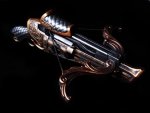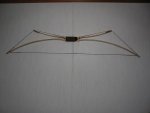doctorbadwolf
Heretic of The Seventh Circle
Okay! I have a character who is an inventor, but is not and will not be an Artificer. Mostly because he is already level 7, MC Rogue/Wizard, and his build is...built...on the story that has happened thus far.
So, in order to help make running this concept in a balanced fashion easier on me and the DM, and to help me in the games I run if someone wants to either gain even more tinkering on their artificer, or gain some tinkering as a non-artificer, without it just being a case of "the DM makes it up as they go".
So, my solution is to build a feat for being an Inventor.
Design goals:
1. A feat that sits below the "broken" feats like Sharpshooter and GWM in power level, even if only just.
2. A feat that the rules of which are easy to apply.
3. Beneficial to Artificers who want greater specialisation and non-Artificers who want to dabble. Like Ritual Caster, which is useful regardless of class, so long as you don't pick wizard as a wizard.
4. Codify non-magical and/or common magical invention in a way that's easy to use.
So, I think that one part of this is to make all inventions that force a save use the 8+int+prof calculation.
Now, some of the things that my character wants to make follow, and I'd love to know what other people have seen players want to invent, and see if we can accommodate most of it in a simple, elegant, feat.
As for damage and cost, Do we make a chart of normal damage outputs by level, using the DMG spell creation table as a guide? Do we have a line on that table for cost by level, as well, and someone with this feat ignores the normal costing for similar adventuring gear?
Arrows of Acid and Alchemist's Fire are simple. In the current game, I spent a workday on each one in research, and two uses worth of gp, in order to make improved versions that get the same punch in a smaller amount of fluid. ie, same damage, but can fit in a hollow arrow or crossbow bolt.
The hollow arrow itself should be part of the feat, I think. And you can put one use of XYZ formulas in an arrow. The arrow costs 1gp each, and bc 5e is simple, it doesn't impact range or accuracy. You're paying for it, it doesn't need a drawback in use.
He is working on a tanglefoot arrow. One way to go is to make an arrow of Ensaring Strike or Entagle or Web, another is to take the Tangle Grenade (DMG?) and make it 5ft instead of 10ft, and use your Invention Save DC.
Frag arrow is simple in general, but what is the damage output guideline for this? The frag grenade is too much for a low level item, at least at any reasonable cost.
Smoke arrow should be pretty easy. I'd be fine with just using the smoke grenade, at your weapon's range.
Away from damage stuff: He wants to make a grappling shot style arrow/launcher device. My vision is either the cord is attached to a device on his crossbow, or on a specially made bracer the party ranger wears. The cord is spider silk thin, compacted into the arrow, and sticks into a creature or object or surface. As part of drawing the arrow, you hook a ring on the arrow to the device. The device allows you to pull the creature or object, or "pull" yourself to the surface, as a bonus action.
Glider Armor. Basically as the flying armor from Princes of The Apocalypse, except it doesn't necessarily allow full flight, but instead a gliding descent, or gliding flight controlled by acrobatics where you have to move your full speed every round until you land, and part of the movement is down unless you can catch an updraft. see, how to train your dragon.
Flashbang applies blindness and deafness on a failed save
Revolver Hand Crossbow is something he already has. Mechanically, it just replaces Loading with Reload 6 (bonus action or instead of an attack with the Attack Action to reload after 6 attacks) https://www.dndbeyond.com/magic-items/688037-revolving-crossbow

Advanced Cable-backed Double Recurve crossbow arms and bow is based on a combination of recurve composite bow technology, and cable-backed bows like this wabanaki bow, and the technology of the inuit cable-back bows. https://en.wikipedia.org/wiki/Cable-backed_bow

These would increase range and/or decrease the difference between primary range and long range, and could increase base damage, depending on balance considerations.
So, in order to help make running this concept in a balanced fashion easier on me and the DM, and to help me in the games I run if someone wants to either gain even more tinkering on their artificer, or gain some tinkering as a non-artificer, without it just being a case of "the DM makes it up as they go".
So, my solution is to build a feat for being an Inventor.
Design goals:
1. A feat that sits below the "broken" feats like Sharpshooter and GWM in power level, even if only just.
2. A feat that the rules of which are easy to apply.
3. Beneficial to Artificers who want greater specialisation and non-Artificers who want to dabble. Like Ritual Caster, which is useful regardless of class, so long as you don't pick wizard as a wizard.
4. Codify non-magical and/or common magical invention in a way that's easy to use.
So, I think that one part of this is to make all inventions that force a save use the 8+int+prof calculation.
Now, some of the things that my character wants to make follow, and I'd love to know what other people have seen players want to invent, and see if we can accommodate most of it in a simple, elegant, feat.
As for damage and cost, Do we make a chart of normal damage outputs by level, using the DMG spell creation table as a guide? Do we have a line on that table for cost by level, as well, and someone with this feat ignores the normal costing for similar adventuring gear?
Arrows of Acid and Alchemist's Fire are simple. In the current game, I spent a workday on each one in research, and two uses worth of gp, in order to make improved versions that get the same punch in a smaller amount of fluid. ie, same damage, but can fit in a hollow arrow or crossbow bolt.
The hollow arrow itself should be part of the feat, I think. And you can put one use of XYZ formulas in an arrow. The arrow costs 1gp each, and bc 5e is simple, it doesn't impact range or accuracy. You're paying for it, it doesn't need a drawback in use.
He is working on a tanglefoot arrow. One way to go is to make an arrow of Ensaring Strike or Entagle or Web, another is to take the Tangle Grenade (DMG?) and make it 5ft instead of 10ft, and use your Invention Save DC.
Frag arrow is simple in general, but what is the damage output guideline for this? The frag grenade is too much for a low level item, at least at any reasonable cost.
Smoke arrow should be pretty easy. I'd be fine with just using the smoke grenade, at your weapon's range.
Away from damage stuff: He wants to make a grappling shot style arrow/launcher device. My vision is either the cord is attached to a device on his crossbow, or on a specially made bracer the party ranger wears. The cord is spider silk thin, compacted into the arrow, and sticks into a creature or object or surface. As part of drawing the arrow, you hook a ring on the arrow to the device. The device allows you to pull the creature or object, or "pull" yourself to the surface, as a bonus action.
Glider Armor. Basically as the flying armor from Princes of The Apocalypse, except it doesn't necessarily allow full flight, but instead a gliding descent, or gliding flight controlled by acrobatics where you have to move your full speed every round until you land, and part of the movement is down unless you can catch an updraft. see, how to train your dragon.
Flashbang applies blindness and deafness on a failed save
Revolver Hand Crossbow is something he already has. Mechanically, it just replaces Loading with Reload 6 (bonus action or instead of an attack with the Attack Action to reload after 6 attacks) https://www.dndbeyond.com/magic-items/688037-revolving-crossbow

Advanced Cable-backed Double Recurve crossbow arms and bow is based on a combination of recurve composite bow technology, and cable-backed bows like this wabanaki bow, and the technology of the inuit cable-back bows. https://en.wikipedia.org/wiki/Cable-backed_bow

These would increase range and/or decrease the difference between primary range and long range, and could increase base damage, depending on balance considerations.
